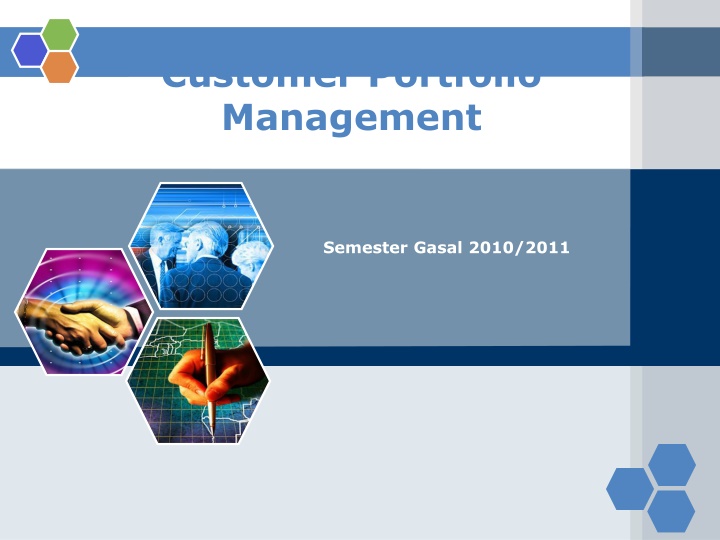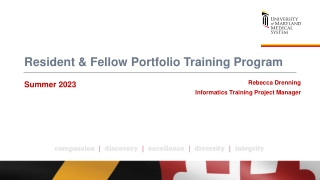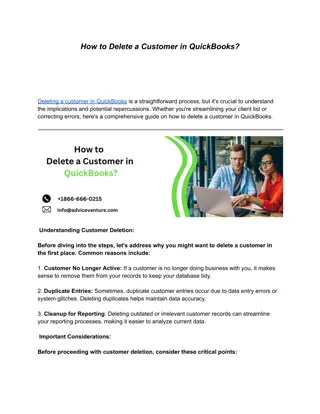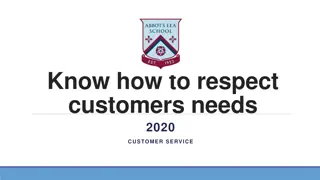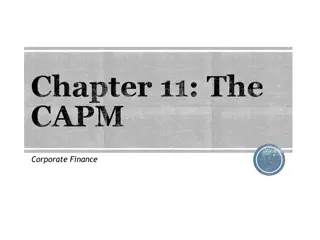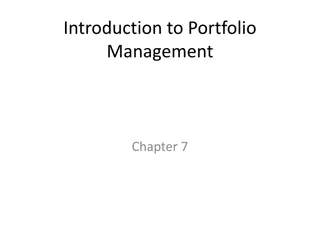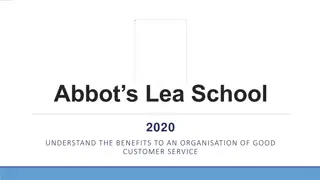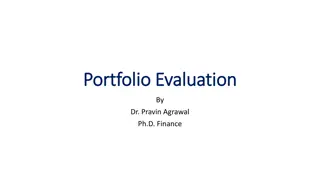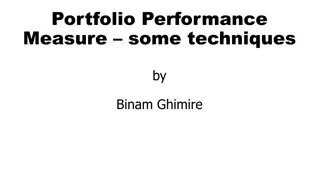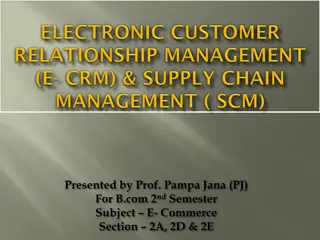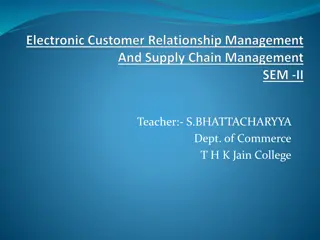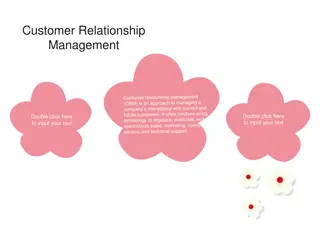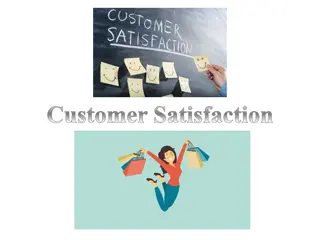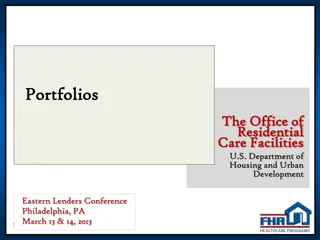Customer Portfolio Management in Business
Customer Portfolio Management (CPM) involves optimizing business performance by offering differentiated value propositions to various customer segments. It includes market segmentation, sales forecasting, activity-based costing, customer lifetime value estimation, and data mining. The process aims to divide the market into subsets for targeted strategies, enhancing customer profitability and overall sales growth.
Download Presentation

Please find below an Image/Link to download the presentation.
The content on the website is provided AS IS for your information and personal use only. It may not be sold, licensed, or shared on other websites without obtaining consent from the author.If you encounter any issues during the download, it is possible that the publisher has removed the file from their server.
You are allowed to download the files provided on this website for personal or commercial use, subject to the condition that they are used lawfully. All files are the property of their respective owners.
The content on the website is provided AS IS for your information and personal use only. It may not be sold, licensed, or shared on other websites without obtaining consent from the author.
E N D
Presentation Transcript
Customer Portfolio Management Semester Gasal 2010/2011
Customer Portfolio Definition The collection of mutually exclusive customer groups that comprise a business s entire customer base
Objectives of Customer Portfolio Management Customer Portfolio Management (CPM) aims to optimise business performance whether that means sales growth, enhanced customer profitability, or something else - across the entire customer base It does this by offering differentiated value propositions to different segments of customers
Basic Disciplines for CPM market segmentation sales forecasting activity-based costing customer life-time value estimation data-mining
Market Segmentation Definition Market segmentation is the process of dividing up a market into more-or-less homogenous subsets for which it is possible to create different value propositions
Intuitive vs. Data-based Segmentation Intuitive brain-storm segmentation variables age, gender, life-style SIC, size, location produce word-profiles compute sizes of segments assess company/segment fit make targeting decision one/several/all segments? Data-based Obtain customer data Internal and external analyse customer data identify high/medium/low value customer segments profile customers within segments age, gender, life-style SIC, size, location assess company/segment fit make targeting decision one/several/all segments?
Market Segmentation Process 1. identify the business you are in 2. identify relevant segmentation variables 3. analyse the market using these variables 4. assess the value of the market segments 5. select target market(s) to serve
Types of Competitor (kitchen furniture example) Benefit competitors other companies delivering the same benefit to customers. These might include window replacement companies, heating and air-conditioning companies and bathroom renovation companies Product competitors other companies marketing kitchens to customers seeking the same benefit. Geographic competitors these are benefit and product competitors operating in the same geographic territory
Criteria for Segmenting Consumer Markets User attributes Demographic attributes: age, gender, occupational status, household size, marital status, terminal educational age, household income, stage of family life- cycle, religion, ethnic origin, nationality Geographic attributes: country, region, TV region, city, city size, post-code, residential neighbourhood Psychographic attributes: life-style, personality Usage attributes Benefits sought, volume consumed, share of category spend
Criteria for Segmenting Business Markets Business market segmentation criteria Illustration International Standard Industrial Classification An internationally agreed standard for classifying goods and service producers Dispersion Size Geographically concentrated or dispersed Large, medium, small businesses: classified by number of employees, number of customers, profit or turnover Account status Global account, National account, Regional account, A or B or C class accounts Account value Buying processes <$50,000, <$100,000, <$200,000, <$500,000 Open tender, sealed bid, internet auction, centralized, decentralized Buying criteria Continuity of supply (reliability), product quality, price, customisation, just-in-time, service support before or after sale Propensity to switch Share of customer spend in the category Satisfied with current suppliers, Dissatisfied Sole supplier, majority supplier, minority supplier, non- supplier Geography Buying style City, region, country, trading bloc (ASEAN, EU) Risk averse, innovator
Examples of ISIC Codes ISIC 4-digit code Activity 1200 2511 Mining of uranium and thorium ores Manufacture of rubber tyres and tubes; re-treading and rebuilding of rubber tyres Restaurants, bars and canteens Higher education 5520 8030
McKinsey/GE Customer Portfolio Matrix High Attractiveness of market segment Medium Low Strong Fit to company and network competencies Average Weak Medium-priority markets Attractive markets Unattractive markets
Sales Forecasting Methods Qualitative methods Customer surveys Sales team estimates Time-series methods Moving average Exponential smoothing Time-series decomposition Causal methods Leading indicators Regression models
Sales Forecasting using Moving Averages Sales volumes 2-year moving average 4-year moving average Year 2002 2003 2004 2005 2006 2007 2008 2009 4830 4930 4870 5210 5330 5660 5440 4880 4900 5040 5270 5495 5550 4960 5085 5267 5410
Costs Vary over the Customer Base [1] Customer acquisition costs Some customers require considerable sales effort to shift them from prospect to first-time customer status: more sales calls, visits to reference customer sites, free samples, engineering advice, guarantees that switching costs will be met by the vendor Terms of trade Price discounts, advertising and promotion support, slotting allowances (cash paid to retailers for shelf- space), extended invoice due-dates
Costs Vary over the Customer Base [2] Customer service costs Handling queries, claims and complaints, demands on sales-person and contact centre, small order sizes, high order frequency, just-in-time delivery, part-load shipments, breaking bulk for delivery to multiple sites. Working capital costs Carrying inventory for the customer, cost of credit.
Activity Based Costing in a Claims Processing Department ABC view: claims processing dept. General ledger: claims processing department $ $ $ $ Actual Variance 620,400 600,000 Plan Key/scan claims 31,500 Salaries (21,400) Equipment 161,200 150,000 (11,200) Analyse claims 121,000 Suspend claims 32,500 Receive provider enquiries 101,500 Resolve member problems 83,400 Process batches 45,000 Determine eligibility 119,000 Make copies 145,500 Write correspondence 77,100 Attend training 158,000 Total 914,500 Travel expenses 2,000 58,000 60,000 Supplies (3,900) 43,900 40,000 Use & Occupancy ----- 30,000 30,000 Total (34,500) 914,500 880,000
How Activity Based Costing Help CPM When combined with revenue figures, it tells you the absolute and relative levels of profit generated by each customer, segment or cohort It guides you towards actions that can be taken to return customers to profit It helps prioritise and direct customer acquisition, retention and development strategies It helps establish whether customisation, and other forms of value creation for customers, pays off
Lifetime Value Formula where LTV = lifetime value m = margin or profit from a customer per period r = retention rate (e.g. 0.8 or 80%) i = discount rate (e.g. 0.12 or 12%)
Data-mining for CPM Clustering techniques Decision trees Neural networks
Credit Risk Training Set Name Joe Sue John Mary Fred Debt High Low Low High Low Income High High High Low Low Married? Yes Yes No Yes Yes Risk Good Good Poor Poor Poor
Cross-tab of Dependent & Independent Variables Predicted risk High debt Low debt High income Low income Not Married married Good 1 1 2 0 2 0 Poor 1 2 1 2 2 1
Shapiro et als Customer Classification Matrix High Carriage trade Passive Received price Bargain basement Aggressive Low Low High Cost-to-serve
How Costs Vary Between Customers Pre-sale costs Production costs Distribution costs Post-sale costs Geographic location: close v. distant Prospecting Order size Shipment consolidation Preferred transportation mode Back-haul opportunity Location: close v. distant Logistics support e.g. field inventory Training Set-up time Installation Sampling Scrap rate Technical support Repairs and maintenance Human resource: management v. reps Service: design support, applications engineering Customization Order timing
Fiocca Step 1 Key difficult Non-key difficult High Difficulty in managing account Key easy Non-key easy Low High Low Strategic importance of account
Fiocca Step 1: Strategic Importance Strategic importance is related to value/volume of the customer s purchases potential and prestige of the customer customer market leadership general desirability in terms of diversification of the supplier s markets, providing access to new markets, improving technological expertise, and the impact on other relationships
Fiocca Step 1: Difficulty of Managing Relationship Difficulty of managing the customer relationship is related to: product characteristics such as novelty and complexity account characteristics such as the customer s needs and requirements, customer s buying behaviour, customer s power, customer s technical and commercial competence and the customer s preference to do business with a number of suppliers competition for the account which is assessed by considering the number of competitors, the strength and weaknesses of competitors and competitors position vis vis the customer
Fiocca Step 2 Assess key easy and key difficult accounts: The customer s business attractiveness The strength of the buyer/seller relationship
Fiocca Step 2: Customer Attractiveness Market factors Financial and economic factors Size of key segments served by customer Customer s share of key segments Customer s margins Customer s scale and experience Customer s growth rate Barriers to customer s entry or exit Customer s influence on the market Customer s capacity utilisation Competition in the customer s market Customer s position and strength Technological factors Customer s ability to cope with change Depth of customer s skills Customer s vulnerability to substitutes Customer s level of integration Types of technological know-how Level of customer patent protection Socio-political factors Customer s ability to adapt and fit
Fiocca Step 2: Strength of Relationship the length of relationship the volume or dollar value of purchases the importance of the customer (percentage of customer s purchases on supplier s sales) personal friendships co-operation in product development management distance (language and culture) geographical distance
Additional CPM Tools SWOT analysis PESTE analysis 5-forces analysis BCG matrix analysis
PESTE Analysis [1] Political environment Demand for international air travel contracted as worldwide political stability was reduced after September 11, 2001 Economic environment Demand for mortgages falls when the economy enters recession Social environment As a population ages, demand for health care and residential homes increase
PESTE analysis [2] Technological environment As more households become owners of computers, demand for internet banking increases Environmental conditions As customers become more concerned about environmental quality, demand for more energy efficient products increases
5-forces Analysis The profitability of an industry as measured by its return on capital employed relative to its cost of capital is determined by 5 sources of competitive pressure 1. competition within the established businesses in the market 2. competition from potential new entrants 3. competition from potential substitutes 4. the bargaining power of buyers 5. the bargaining power of suppliers.
BCG Matrix High STA R QUESTION MARK Cash use equals cash generation Heavy cash users Strategy: Aggressive growth or divest Strategy: Grow and build Market growth DOG CASH COW Cash generators Cash users Strategy: Maintain and milk Strategy: Divest Low 10x 1x 0.1x Relative market share Product evolution Direction of cash movement
Strategically Significant Customer [1] High future life-time value customers These customers will contribute significantly to the company s profitability in the future High volume customers These customers might not generate much profit, but they are strategically significant because of their absorption of fixed costs, and the economies of scale they generate to keep unit costs low
Strategically Significant Customers [2] Benchmark customers These are customers that other customers follow EX. Nippon Conlux supplies the hardware and software for Coca Cola s vending operation Whilst they might not make much margin from that relationship, it has allowed them to gain access to many other markets If we are good enough for Coke, we are good enough for you , is the implied promise Some IT companies create reference sites at some of their more demanding customers
Strategically Significant Customers [3] Inspirations These are customers who bring about improvement in the supplier s business They may identify new applications for a product, product improvements, or opportunities for cost reductions They may complain loudly and make unreasonable demands, but in doing so, force change for the better Door openers These are customers that allow the supplier to gain access to a new market This may be done for no initial profit, but with a view to proving credentials for further expansion This may be particularly important if crossing cultural boundaries, say between west and east
SSCs at a Scandinavian Timber Processor This company considers 5 attributes in identifying their strategically significant customers Economic return Future business potential Learning value Reference value Strategic value by providing access to new markets strengthening incumbent positions building barriers to new entrants
Core Customer Management Strategies 1. Protect the relationship 2. Re-engineer the relationship 3. Enhance the relationship 4. Harvest the relationship 5. End the relationship 6. Win-back the customer 7. Start a relationship
References Francis Buttle, Customer Relationship Management: Concepts and Technologies, 2e, Elsevier Ltd., 2009 Baran, Galka and Strunk, Principles of Customer Relationship Management, South-Western, 2008
